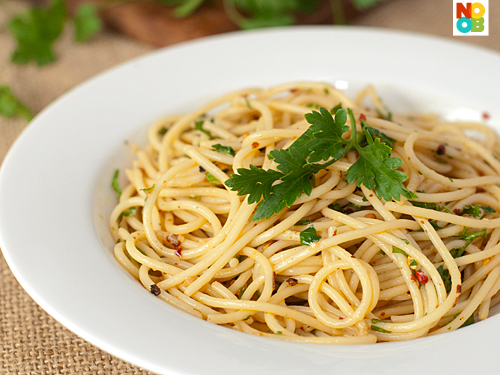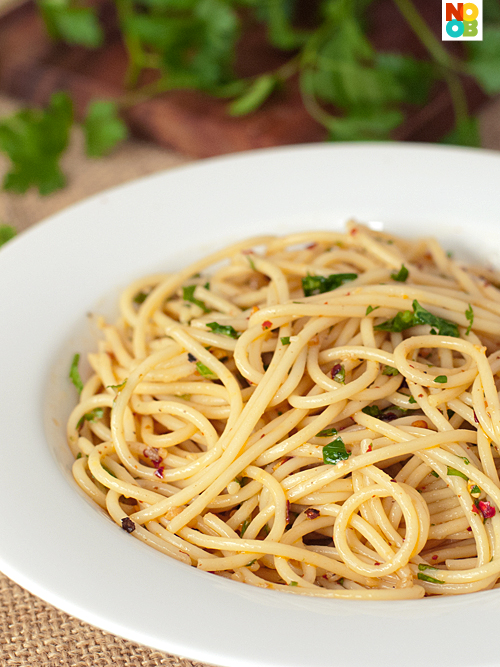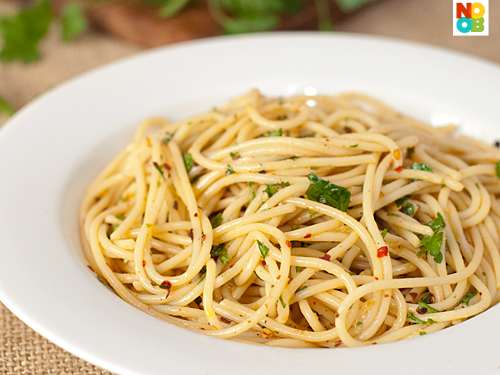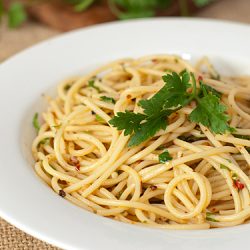Aglio Olio Recipe

See this recipe on the next page >>
Note: First posted in Oct 2007, now updated with new photos and improved recipe.
Aglio e Olio is one of my favourite Italian pasta dishes. Aglio e Olio means “Garlic and Oil” in Italian, and one of the simplest pasta dishes to make. This is one dish which I don’t mind drenched in (good-quality olive) oil. Authentic Aglio e Olio only have a few key ingredients – just garlic, olive oil and pasta, so this is something you can whip up with minimum ingredients.
You May Also Like: Mushroom Spaghetti Recipe
While I do enjoy indulging in tomato-based or cream-based pasta now and then, the law of diminishing returns often sets in whenever I eat creamy pastas, where I find my enjoyment diminishing halfway through. But for the light-and-fresh-tasting Aglio e Olio, I find that I can easily finish my plate and still left hungry for just a bit more.
Tips for making perfect aglio olio, every time
- Pasta should be cooked in salted water which is almost as salty as sea water. The cooked pasta will taste salted and this will reduce or eliminate the need to salt the dish later.
- Do not add oil when cooking the pasta as doing so will prevent the pasta from absorbing the salt or the overall flavour of the dish.
- Al dente is an Italian terms referring to perfectly cooked pasta which is firm (but not hard), and with a slight bite. Tip from my Italian friend Isa on how to tell if pasta is “al dente” – “usually the best way is to taste it, but here’s another method for inexperienced people: if you take a spaghetti string that’s cooking and cut it, you should see a white dot in the middle that’s still hard. This means the pasta is not cooked yet. As soon as the white dot disappears (but the middle part is still a bit hard), then the pasta is “al dente” and you can drain it!”
- Reserve some water from cooking the pasta and add a few tablespoons of it to the final dish. The pasta water not only helps to bind the ingredients, the starch in the pasta water will give the dish a smoother finish.
- Because you are working with minimum ingredients, the quality of the ingredients will make a huge difference. Go for good quality olive oil and fresh parsley, where possible. Always use fresh garlic instead of pre-chopped bottled garlic.
- Tip for making perfect golden brown, not burnt garlic: the oil temperature must be just right when you add the garlic, meaning the garlic should sizzle gently in the heated oil when added to the pan (if the oil splatters violently or no reaction when garlic is added, it means the oil is either over-heated or not heated enough).
- Another tip for making perfect golden brown garlic: monitor the colour of the garlic as they cook in the oil. Turn off the stove once the garlic turns light golden brown. The garlic will continue cooking in the hot oil until it turns a lovely golden brown. If you only turn off the stove when they reached the golden brown hue, they will continue cooking in the hot oil and become burnt. Should the garlic not reach the desired golden brown, simply heat up the oil for another 5-10 seconds, turn off the stove and let the garlic continue browning on its own.
- This finishing touch may not follow the authentic Italian recipe and is entirely optional, but adding a few small cubes of butter at the end will help give the pasta dish additional flavour and a smooth, velvety finish.
- Authentic Aglio e Olio is plain. However, it is now popular to add other ingredients like seafood, mushrooms or meat to the basic Aglio e Olio to make a more complete meal.

Aglio Olio Recipe
With this basic recipe aglio olio, you can make any variation (e.g. with mushrooms and seafood). Don’t forget to check out the tips on page 1 for making perfect aglio olio, every time.
Ingredients:
- 2 servings of pasta (I’m using 150g spaghetti)
- 1 1/2 tbsp olive oil
- 10 cloves garlic peeled and sliced or chopped (but not too finely)
- 1/2 tsp dried chilli flakes may substitute with finely chopped chilli padi
- 30 grams Italian flat-leaf parsley finely chopped
- 20 grams butter cubed
- sea salt to taste
- freshly cracked black pepper to taste
Directions:
- Bring a pot of water with 1 tbsp sea salt to a boil. Cook pasta according to the timing indicated on the packet, until al dente. Drain and set aside the pasta, reserving a small cup of pasta water.
- Heat olive oil in a sauce pan, add garlic and chilli padi/chilli flakes (if using). Saute the garlic until it turns light golden brown.
- Turn off the stove. The garlic will continue cooking in the hot oil on its own for a few more seconds in the hot oil, until they turn a lovely golden brown.
- Add cooked pasta, 1-2 tbsp reserve pasta water, chopped parsley and cubed butter to the garlic & oil mixture. Stir to coat all the ingredients evenly. Season with sea salt and freshly cracked black pepper.

